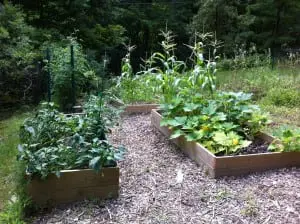By Pamela Doan
A reader asked: “No-till gardening and lasagna gardening are mentioned frequently in this column. How can I get started?”
 If you’re ready to give up the backbreaking work of digging and rototilling your garden and flower beds every year, here’s an outline to get started. No-till gardens and lasagna gardening both refer to an easy approach that is also a way to prevail over our rocky and slightly acidic soil tendencies in Putnam County. Instead of tearing up the ground, simply create beds on top. Organic matter, which many people have in their yards already, is used as the layers of the “lasagna.” No topsoil is necessary, and an afternoon of work can create a rich garden soil that holds water, drains well and has fewer weeds.
If you’re ready to give up the backbreaking work of digging and rototilling your garden and flower beds every year, here’s an outline to get started. No-till gardens and lasagna gardening both refer to an easy approach that is also a way to prevail over our rocky and slightly acidic soil tendencies in Putnam County. Instead of tearing up the ground, simply create beds on top. Organic matter, which many people have in their yards already, is used as the layers of the “lasagna.” No topsoil is necessary, and an afternoon of work can create a rich garden soil that holds water, drains well and has fewer weeds.
Last year I set up three beds with wood sides and one bed that wasn’t enclosed. I did very little weeding, and my soil held water beautifully. Happy plants.
Creating a no-till vegetable garden
Determine where the garden will get lots of sunlight. Most vegetables need six to eight hours of sun every day.
Measure the space and make a diagram where the beds will go. All mine are crooked and not quite level, but the corn doesn’t seem to care. If right angles are important to you, mark the ground with string to set them up.
Raised beds can be made of many materials, including bricks, blocks and wood. I used cedar planks to make my beds, because cedar is naturally rot-resistant and untreated. Twelve-inch-wide planks are available and make a perfect depth. I’ve tried two different sizes, 3 by 8 foot and 4 by 8 foot. The 3-by-8s are on the outside of the garden, and I can push them right up to the deer fence and still reach across it. The 4-by-8-foot beds need to be accessible on three or four sides, though, unless you have basketball-player limbs.
 If using treated wood, line the bed with landscape fabric to prevent the chemicals from leaching into your soil. Twelve inches deep is entirely sufficient, but making the beds higher means less bending and stooping. Adding a ledge around the top edge looks nice and functions as a place to sit or keep tools.
If using treated wood, line the bed with landscape fabric to prevent the chemicals from leaching into your soil. Twelve inches deep is entirely sufficient, but making the beds higher means less bending and stooping. Adding a ledge around the top edge looks nice and functions as a place to sit or keep tools.
Attach hardware cloth, a heavy-duty wire mesh, to the bottom of the bed to keep out voles and other critters that will want to burrow up into your bed. Do not skip this step. Once the beds are in use, taking them apart to add it once you have invaders is a drag.
Once you have the bed built and in place, start with a layer of cardboard or newspaper on the bottom, overlapping the edges. This suppresses weeds and keeps anything that was growing under the box from growing up into it. Soak the newspaper or cardboard with water before you layer on top of it.
I add a layer of wood chips to my boxes because I have a huge pile that’s been sitting and decomposing nicely for several years. As a general rule, use wood chip mulch around trees and in beds only after it’s been aged for more than a year. Use fresher mulch for paths.
Next, add layers of peat moss alternating with organic matter, any of the following: compost — you can make your own using vegetable and fruit scraps, coffee grounds, grass clippings, shredded leaves and other plant material; hay; sawdust; straw; or wood ashes.
In my experience, a 4-by-8-foot bed needs about one 3-cubic-foot bag in this formula — peat moss, shredded leaves, peat moss, compost, peat moss, compost.
Here’s a great tip passed along from another master gardener. Shred leaves in a barrel or trash can using a weed whacker. It’s like a giant immersion blender. Make sure to use protective eyewear, though — no need to blind yourself for a tomato.
For further reference, check out Lasagna Gardening by Patricia Lanza or this guide on Cornell’s website.
Garden questions? Send them here: [email protected].
Photos by P. Doan

